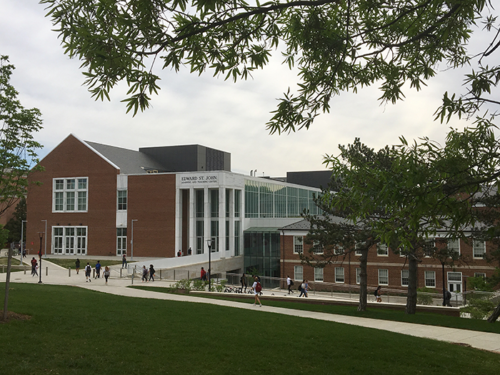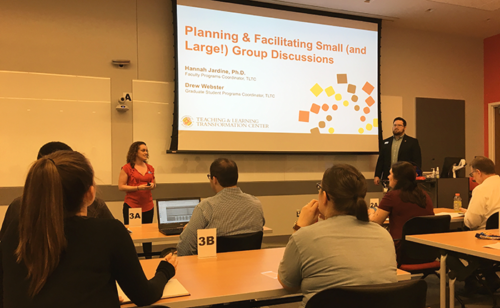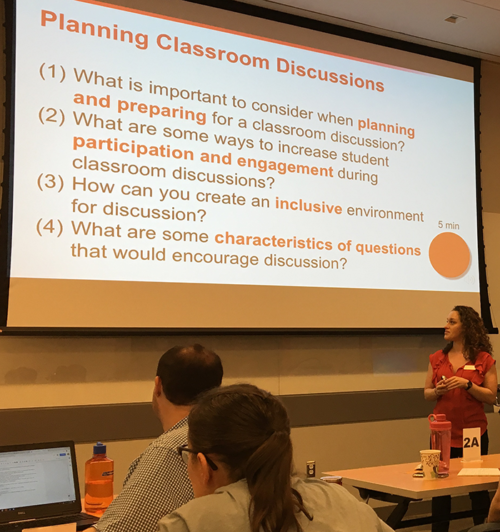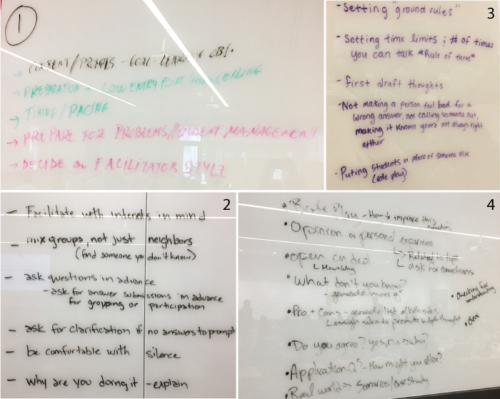Discussing Discussions: How to facilitate engaging and inclusive group discussions
Suzanne Webster ·
This is the second blog in a short series of posts reflecting on professional development workshops that I recently attended at the University of Maryland Teaching & Learning Transformation Center (TLTC). This second workshop was called “Planning & Facilitating Small (and Large!) Group Discussions”. The workshop was held in the Edward St. John Learning and Teaching Center on April 18, 2019, and was facilitated by Faculty Programs Coordinator Dr. Hannah Jardine and Graduate Student Programs Coordinator Drew Webster.

This workshop was a series of meta-experiences— the facilitators led a discussion about discussions by making use of several of the actual discussion techniques that they described throughout the course of the workshop. First, attendees were each assigned a seat as we entered the room so that we ended up sitting in groups of four people. We then engaged in a structured think-pair-share activity to set expectations for the discussion that we would have throughout the course of the workshop. The facilitators explained that formally setting expectations for participation can help create an environment that is inclusive and collaborative. As a room, we agreed on a set of expectations for the day—for example, we expected that the facilitators would provide clear instructions, and accommodate people with diverse learning abilities and participation styles, while we expected all workshop participants to practice active listening and meaningfully engage with each other’s comments before introducing a new direction for the discussion.

For the bulk of the workshop, we participated in a jigsaw group discussion centered around four questions about planning discussions. During this discussion, each group of four sent one member to each corner of the room, and each resulting corner group tackled one of the given questions. After a few minutes, everyone returned to our original groups of four and shared some of the highlights from our individual discussions. I have never used this discussion strategy before, but I really liked it because it was an efficient and less intimidating way for each person in the room to learn from all other workshop attendees, rather than only the three other people in their small group. Here are some of my main takeaways from each of the four questions:
1. What is important to consider when planning
and preparing for a classroom discussion?
Instructors and facilitators should always think about
the overall learning outcomes of the course or particular class meeting, and
make sure there is a strong rationale for using a discussion format to achieve
those outcomes. After determining that a discussion format is appropriate, it
is important to consider what facilitation style would be most effective (e.g.
more hands-on vs. student-led) based on the subject matter to be discussed and
the group dynamic. It can also be good practice for facilitators to share their
rationale behind their planning decisions (e.g. we are setting expectations
because…) so that students know what they are supposed to gain from each
discussion experience.

2. What are some ways to increase student
participation and engagement during classroom discussions?
Always remember one thing: “Facilitate, don’t dominate”. Instructors and facilitators should plan ahead to strategically arrange the room and include a variety of active learning strategies in their agendas in order to maximize student-to-student interaction. As in group work, it can sometimes be helpful to designate roles for participants. Instructors should consider providing a guide to structure student learning, which could be a printed worksheet to fill in during discussion time, or asking students to generate three main points to share at the end of the discussion. These types of guides can also function as a way to assess whether or not students are achieving the learning outcomes. One suggestion that I plan to do in the future is to provide discussion participants with a short list of questions ahead of time. This gives people a chance to prepare more thoughtful answers, and can engage people who are normally less eager to participate.
3. How can you create an inclusive environment
for discussion?
It is important to put some thought into establishing an inviting and comfortable climate that encourages participation. Instructors should ideally learn everyone’s name, get to know all discussion participants as individuals and as a group, and make themselves more approachable by minimizing the gap between themselves and the students. Creating discussion expectations and engaging in ice breaker activities and questions can help achieve these outcomes. Instructors should also avoid shaming or embarrassing students for wrong answers or “first-draft thoughts,” and instead model how to disagree respectfully and build upon incorrect or incomplete responses to enrich everyone’s learning experience.

4. What are some characteristics of questions that
would encourage discussion?
Discussion questions should be open-ended and have more than one acceptable answer. When leading a discussion, facilitators should come prepared with a balanced list of questions that vary in their level of difficulty and require respondents to use different types of analytical and evaluative skills, or cognitive processes, to provide answers. One point that resonated with me was that instructors should plan discussions under the assumption that participants will not be equally prepared. Sometimes it can be frustrating to lead (or participate in) a discussion when it is obvious that some members of the group did not do the expected preparatory work. In these circumstances, facilitators can improve the discussion experience for everyone by asking questions that purposefully include everyone, such as questions that draw on participants’ own opinions or personal experiences, in relation to a central theme being discussed. I liked the way that one of the groups phrased this—facilitators should lead discussions by asking questions that have a “low entry point, but a high ceiling” so that all participants can contribute to some degree, either at the beginning or by building off of others’ contributions.
All in all, this workshop was a thought-provoking and
informative experience, and I am inspired to try to use some of these techniques
when facilitating discussions in upcoming courses and workshops offered through
UMCES and beyond. In an upcoming blog, I will discuss other strategies and technologies
that can be used to improve teaching and learning experiences.
About the author
Suzanne Webster

Suzi Webster is a PhD Candidate at UMCES. Suzi's dissertation research investigates stakeholder perspectives on how citizen science can contribute to scientific research that informs collaborative and innovative environmental management decisions. Her work provides evidence-based recommendations for expanded public engagement in environmental science and management in the Chesapeake Bay and beyond. Suzi is currently a Knauss Marine Policy Fellow, and she works in NOAA’s Technology Partnerships Office as their first Stakeholder Engagement and Communications Specialist.
Previously, Suzi worked as a Graduate Assistant at IAN for six years. During her time at IAN, she contributed to various communications products, led an effort to create a citizen science monitoring program, and assisted in developing and teaching a variety of graduate- and professional-level courses relating to environmental management, science communication, and interdisciplinary environmental research. Before joining IAN, Suzi worked as a research assistant at the Marine Biological Laboratory in Woods Hole, MA and received a B.S. in Biology and Anthropology from the University of Notre Dame.
Next Post > Supporting collaborative learning: Teaching tips for facilitating group work
Comments
-
Atika 8 months ago
Thank you for sharing this great information with us, i really appreciate your post!
-
Atika 4 months ago
Thank you for sharing this great information with us, i really appreciate your post!